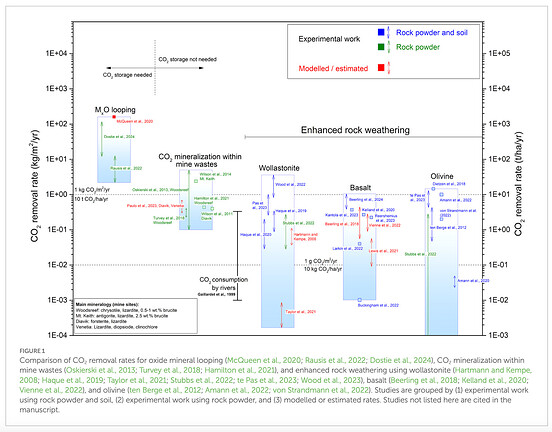Are enhanced rock weathering rates overestimated? A few geochemical and mineralogical pitfalls
This week, we take a deep dive into a paper recently published in Frontiers in Climate. The study was conducted by a team of researchers based in Canada, led by Ian M. Power from the Trent School of the Environment of Trent University, in Peterborough (Canada).
The paper critically examines the potential overestimation in the projected rates of enhanced rock weathering (ERW), a proposed carbon dioxide removal (CDR) strategy that involves spreading finely ground silicate rocks over land to accelerate CO₂ sequestration through mineral dissolution. However, the accuracy of projected weathering rates has significant implications for assessing ERW’s feasibility as a large-scale climate mitigation strategy. The authors identify key geochemical and mineralogical factors that may lead to inflated estimates of weathering efficiency and CO₂ sequestration potential. While faster ERW rates would imply a significant chance to impact climate change mitigation and more carbon credits to the benefit of private companies, an overestimation could undermine the credibility of ERW. The paper contributes to this discussion by describing three potential pitfalls relating to the geochemical and mineralogical compositions of rock powders.
First, the study highlights potential overestimations in ERW efficiency due to assumptions about the complete dissolution of minerals. Rock powders used for ERW are often mineralogically complex and may initially exhibit fast dissolution rates due to reactive surfaces and phases, leading to overestimating long-term CDR rates: as weathering kinetics vary widely among minerals, certain silicate phases might persist longer than expected. Second, secondary mineral formation (e.g., clays, carbonates) could reduce the net CO₂ sequestration efficiency by trapping cations before they contribute to long-term storage. Third, commonly used experimental setups might not fully replicate natural soil environments, leading to discrepancies between modeled and real-world ERW performance. For example, methods that rely on measuring cations may be prone to misinterpretation as cations will often not be balanced with dissolved inorganic carbon, e.g., during strong acid weathering.
As a result, the authors argue that many current ERW models may not fully account for the slower dissolution rates of certain minerals, meaning that projected CO₂ drawdown rates may be optimistic. Improved geochemical models that incorporate mineral-specific kinetics, secondary phase formation, and field-validated weathering rates could overcome these limitations.
Here is a list of the main takeaways from this paper:
- Weathering rates may be overestimated due to unrealistic assumptions about complete mineral dissolution in ERW models, as field conditions often lead to slower and incomplete reactions.
- Secondary minerals can reduce CO₂ capture by trapping cations before they contribute to long-term carbon storage, challenging the effectiveness of ERW as a climate solution.
- Mineral composition affects dissolution rates, with some silicate phases weathering much slower than others, and lab experiments may not fully reflect how the process will take place in real-world conditions.
- Current ERW models may be too optimistic, overlooking geochemical complexities and mineral heterogeneity: more field-validated data is needed for accurate predictions.
- Improved modeling and field studies are essential to refine ERW’s projected climate benefits and assess its true carbon sequestration potential.
Read the full paper here: Are enhanced rock weathering rates overestimated? A few geochemical and mineralogical pitfalls
